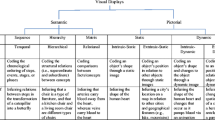Abstract
Abstract thought has roots in the spatial world. Abstractions are expressed in the ways things are arranged in the world as well as the ways people talk and gesture. Mappings to the page should be better when they are congruent, that is, when the abstract concept matches the spatial one. Congruent mappings can be revealed in people’s performance and preferences. Congruence is supported here for visual representations of continuum and category. Congruently mapping a continuous concept, frequency, to a continuous visual variable and mapping a categorical concept, class inclusion, to a categorical visual variable were preferred and led to better performance than the reverse mappings.
Access this chapter
Tax calculation will be finalised at checkout
Purchases are for personal use only
Preview
Unable to display preview. Download preview PDF.
Similar content being viewed by others
References
Bertin, J.: Graphics and Graphic Information Processing. Walter de Gruyter, New York (1981)
Boroditsky, L.: Metaphoric Structuring: Understanding Time Through Spatial Metaphors. Cognition 75, 1–28 (2000)
Cleveland, W.S.: The Elements of Graphing Data. Wadsworth, Monterey (1985)
Cooper, W.E., Ross, J.R.: World Order. In: Grossman, R.E., San, L.J., Vances, T.J. (eds.) Papers From the Parasession on Functionalism, pp. 63–111. Chicago Linguistic Society, Chicago (1975)
Harel, D.: Statecharts: A Visual Formalism for Complex Systems. Science of Computer Programming 8, 231–274 (1987)
Kessell, A.M., Tversky, B.: Visualizing Space, Time, and Agents: Production, Performance, and Preference. Cognitive Processing 12, 43–52 (2011)
Lakoff, G., Johnson, M.: Metaphors We Live By. University of Chicago Press, Chicago (1980)
Landy, D., Goldstone, R.L.: How Abstract is Symbolic Thought? Journal of Experimental Psychology: Learning, Memory, & Cognition 33, 720–733 (2007)
Nickerson, J.V., Tversky, B., Corter, J.E., Yu, L., Mason, D.: Thinking with Networks. In: Proceedings of the 32nd Annual Conference of the Cognitive Science Society (2010)
Norman, D.A.: Things That Make us Smart. Addison-Wesley, Reading (1993)
Novick, L.R., Hurley, S.M.: To Matrix, Network, or Hierarchy: That is the Question. Cognitive Psychology 42, 158–216 (2001)
Shepard, R.N.: Perceptual-cognitive Universals as Reflections of the World. Behavioral and Brain Sciences 24, 581–601 (2001)
Talmy, L.: How language Structures Space. In: Pick Jr., H.L., Acredolo, L.P. (eds.) Spatial Orientation: Theory, Research and Application, pp. 225–282. Plenum, New York (1983)
Tollis, I.G., Di Battista, G., Eades, P., Tamasssia, R.: Graph Drawing: Algorithms for the Visualization of Graphs. Prentice Hall, New York (1998)
Tversky, B.: Spatial schemas in depictions. In: Gattis, M. (ed.) Spatial Schemas and Abstract Thought, pp. 79–111. MIT Press, Cambridge (2001)
Tversky, B.: Tools for Thought. In: Benedetti, B., Cook, V. (eds.) Language and Bilingual Cognition, pp. 131–139. Psychology Press, New York (2011a)
Tversky, B.: Visualizing Thought. Topics in Cognitive Science 3, 499–535 (2011b)
Tversky, B., Agrawala, M., Heiser, J., Lee, P.U., Hanrahan, P., Phan, D., Stolte, C., Daniel, M.-P.: Cognitive Design Principles for Generating Visualizations. In: Allen, G. (ed.) Applied Spatial Cognition: From Research to Cognitive Technology, pp. 53–73. Erlbaum, Mahwah (2007)
Tversky, B., Kugelmass, S., Winter, A.: Cross-cultural and Developmental Trends in Graphic Productions. Cognitive Psychology 23, 515–557 (1991)
Tversky, B., Morrison, J.B., Betrancourt, M.: Animation: Can it Facilitate? International Journal of Human Computer Studies 57, 247–262 (2002)
Tversky, B., Zacks, J., Lee, P., Heiser, J.: Lines, Blobs, Crosses and Arrows: Diagrammatic Communication with Schematic Figures. In: Anderson, M., Cheng, P., Haarslev, V. (eds.) Diagrams 2000. LNCS (LNAI), vol. 1889, pp. 221–230. Springer, Heidelberg (2000)
Zacks, J., Tversky, B.: Bars and Lines: A Study of Graphic Communication. Memory and Cognition 27, 1073–1079 (1999)
Zahner, D., Corter, J.E.: The process of probability problem solving: Use of external visual representations. Mathematical Thinking and Learning 12, 177–204 (2010)
Zhang, J.: External representations in complex information processing tasks. In: Kent, A. (ed.) Encyclopedia of Library and Information Science, vol. 68, pp. 164–180. Marcel Dekker, Inc., New York (2000)
Author information
Authors and Affiliations
Editor information
Editors and Affiliations
Rights and permissions
Copyright information
© 2012 Springer-Verlag Berlin Heidelberg
About this paper
Cite this paper
Tversky, B., Corter, J.E., Yu, L., Mason, D.L., Nickerson, J.V. (2012). Representing Category and Continuum: Visualizing Thought. In: Cox, P., Plimmer, B., Rodgers, P. (eds) Diagrammatic Representation and Inference. Diagrams 2012. Lecture Notes in Computer Science(), vol 7352. Springer, Berlin, Heidelberg. https://doi.org/10.1007/978-3-642-31223-6_8
Download citation
DOI: https://doi.org/10.1007/978-3-642-31223-6_8
Publisher Name: Springer, Berlin, Heidelberg
Print ISBN: 978-3-642-31222-9
Online ISBN: 978-3-642-31223-6
eBook Packages: Computer ScienceComputer Science (R0)




